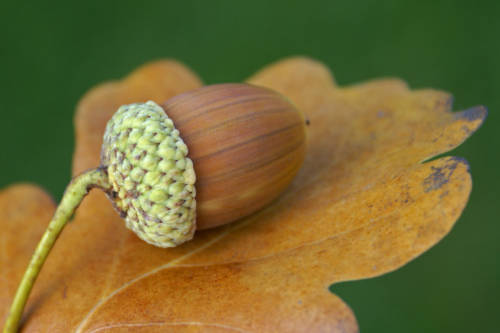Understanding the Symbolism of the Acorn
For many, the unassuming acorns that fall from an oak tree are the bane of those with driveways and front lawns that they’d like to keep clean underfoot. But in recent years, there has been a growing trend towards finding an alternative use for acorns, rather than just raking them together in a seemingly endless heap.
In many ways, acorns are the crystallization of the recent wild, foraged food trend; they are frequently considered an annoyance (like nettles) but are secretly a superfood– a gluten-free nut and grain alternative that’s high in amino acids.
Acorns can also be stored in their shells for years, and– when properly treated– can be used in a multitude of recipes, infusing nutrients and essential vitamins wherever they are added.
Eating acorns is, of course, not a recent trend; along with their progenitor, the oak tree, they have long been revered as a resource, with a rich history in mythologies around the world. In Sanskrit, the word for oak evokes the concept of thunder, life, soul, and spirit; for the Druids, the oak tree was the most sacred tree– so much so that historians believe the word “Druid” itself is from the Celtic word for “acorn”. Abundant as they are, it’s little surprise that acorns have long been consumed both as a delicacy and as an everyday meal.
Acorns are a token of nature’s alchemical magic: a tiny, hardened nut transforms into a tall, wizened tree.
In America, most people know that Native American tribes– particularly those in California– make use of acorns, cooking them into porridge, pancakes, cakes, breads, soups, and patties.
But internationally, different cultures across the world have found their own ways of adopting the nut and incorporating it into their cuisine: in Korea, acorns are transformed into a jelly known as dotorimuk while in Turkey acorns are buried in the dirt to remove tannins (which is the compound that gives acorns their bitter taste) before being washed, dried, and ground with spices into a drink known as raccahout.
Outside of direct human consumption, acorns also have had an important culinary role: jamon iberico, derived from pigs raised on acorns, is considered a Spanish specialty, and oak trees are being planted to help support truffle production. Historically, acorns have also enjoyed uses outside of the gustatory world, used as dye and prepared into a medicine taken by Native American elders to promote longevity.
Today, acorns are becoming more of a mainstream commodity as foraging increasingly becomes a popular activity, one that has spread beyond the realm of picking berries and gathering mushrooms.
Acorns are cropping up in classic recipes (acorn mousse anyone?), especially as acorn flour becomes more readily available and mechanization has cut out the long and arduous process of leaching tannins by oneself (which in days of yore could sometimes take months).
If you do want to forage your own acorns, there are a few things to keep in mind. Broadly, oaks can be sorted into two categories: white oaks and red oaks. White oaks are the more popular variety among hungry mammals, as white oak acorns contain fewer tannins (and are therefore less bitter).
According to Honest Food, the sweetest acorns are the Emory oak, the Pin oak, the Valley oak, Blue oaks, the Burr oak, the Cork oak and the Bellota oak. Of course, it’s also important to keep in mind that among those varieties with sweeter acorns, some acorns are more likely to be edible than others.
Conventional folk wisdom dictates that acorns picked from the tree are watery when mashed, so look for acorns along the ground (just make sure they don’t have any holes!). Another safe rule of thumb to abide by is that the larger the cap, the more bitter the acorn will be.
Whether you end up using them or not, foraging for acorns can be a fun activity, even if they are just scattered as decoration during Fall events or on your Thanksgiving table. If nothing else, acorns are a token of nature’s alchemical magic: a tiny, hardened nut transforms into a tall, wizened tree.




































